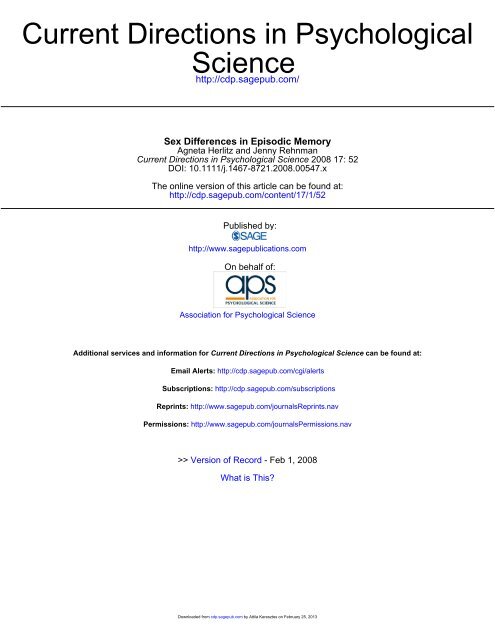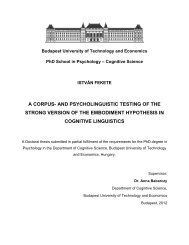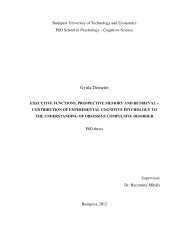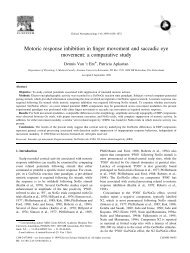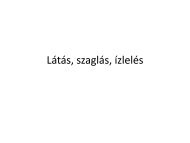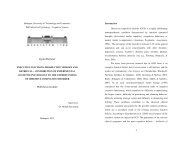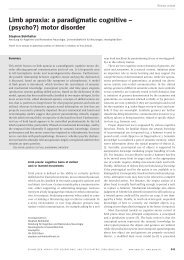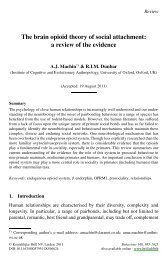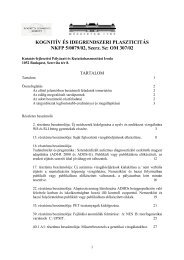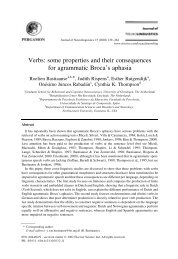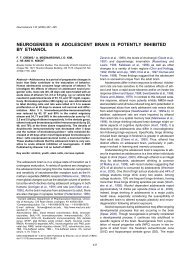Herlitz, Rehnman (2008)
Herlitz, Rehnman (2008)
Herlitz, Rehnman (2008)
Create successful ePaper yourself
Turn your PDF publications into a flip-book with our unique Google optimized e-Paper software.
Current Directions in Psychological<br />
Science<br />
http://cdp.sagepub.com/<br />
Sex Differences in Episodic Memory<br />
Agneta <strong>Herlitz</strong> and Jenny <strong>Rehnman</strong><br />
Current Directions in Psychological Science <strong>2008</strong> 17: 52<br />
DOI: 10.1111/j.1467-8721.<strong>2008</strong>.00547.x<br />
The online version of this article can be found at:<br />
http://cdp.sagepub.com/content/17/1/52<br />
Published by:<br />
http://www.sagepublications.com<br />
On behalf of:<br />
Association for Psychological Science<br />
Additional services and information for Current Directions in Psychological Science can be found at:<br />
Email Alerts: http://cdp.sagepub.com/cgi/alerts<br />
Subscriptions: http://cdp.sagepub.com/subscriptions<br />
Reprints: http://www.sagepub.com/journalsReprints.nav<br />
Permissions: http://www.sagepub.com/journalsPermissions.nav<br />
>> Version of Record - Feb 1, <strong>2008</strong><br />
What is This?<br />
Downloaded from<br />
cdp.sagepub.com by Attila Keresztes on February 25, 2013
Sex Differences in Episodic<br />
Memory<br />
Agneta <strong>Herlitz</strong> 1 and Jenny <strong>Rehnman</strong> 1,2<br />
1 Aging Research Center, Karolinska Institutet, Stockholm, Sweden, and 2 Stockholm University, Stockholm, Sweden<br />
ABSTRACT—Research shows sex differences in episodic<br />
memory. These differences vary in magnitude as a function<br />
of the type of material to be remembered. Throughout the<br />
life span, verbal episodic-memory tasks yield differences<br />
favoring women. In contrast, episodic-memory tasks requiring<br />
visuospatial processing result in differences favoring<br />
men. There are also sex differences favoring women<br />
on episodic-memory tasks requiring both verbal and visuospatial<br />
processing and on face-recognition tasks. Thus,<br />
there may be a small, general episodic-memory advantage<br />
for women—an advantage that can increase by the advantage<br />
women have over men in verbal production and<br />
can be reversed by the male advantage in visuospatial<br />
tasks. In addition, environmental factors affect the magnitude<br />
of the sex differences in episodic memory.<br />
KEYWORDS—sex differences; episodic memory; visuospatial;<br />
verbal<br />
Being able to remember events from one’s past is essential for<br />
functioning in society. By now, it is well known that a number of<br />
factors, among them age and education, affect one’s ability to<br />
remember. Whether one’s sex also influences the ability to remember<br />
everyday events is less well researched. One reason<br />
may be that, in the first comprehensive review of this subject,<br />
Maccoby and Jacklin (1974) did not find sex differences in<br />
memory. However, the theoretical model of memory used by<br />
those researchers was different from that of current theories,<br />
which may explain why they did not find sex differences.<br />
EPISODIC MEMORY<br />
Although several theories of memory exist today, most investigators<br />
would agree that memory can be subdivided into two<br />
broad categories: working memory (or short-term memory) and<br />
long-term memory. Long-term memory can in turn be divided<br />
Address correspondence to Agneta <strong>Herlitz</strong>, Aging Research Center,<br />
Karolinska Institutet, Gävlegatan 16, S-113 30 Stockholm, Sweden;<br />
e-mail: agneta.herlitz@ki.se.<br />
CURRENT DIRECTIONS IN PSYCHOLOGICAL SCIENCE<br />
into subsystems, one being episodic memory. Episodic memory<br />
refers to the conscious recollection of unique personal experiences<br />
in terms of their content (what), location (where), and<br />
temporal occurrence (when; Tulving, 2001). Episodic memory<br />
is typically assessed by first presenting some information (e.g.,<br />
episodes, words, objects, or faces), and by then asking the person<br />
to recall or recognize the earlier-presented information.<br />
What Impact Does Task Material Have on Sex Differences<br />
in Episodic Memory?<br />
Although Maccoby and Jacklin (1974) did not find sex differences<br />
in memory, many more recent studies have found sex<br />
differences favoring women in episodic-memory tasks. For example,<br />
in a large population-based study of 1,000 adults between<br />
35 and 80, we found sex differences on episodic-memory<br />
tasks in which the participants were told to try to remember lists<br />
of words, objects, or activities that had been presented earlier<br />
(<strong>Herlitz</strong>, Nilsson, & Bäckman, 1997). The difference between<br />
men and women on a word-recall task was d 5 .25 (see Fig. 1).<br />
d is computed by calculating the difference between the means<br />
of women and men, divided by the pooled standard deviation.<br />
Here, a positive value indicates that women perform at a higher<br />
level than men, and a negative value indicates that men outperform<br />
women. The closer the value is to zero, the smaller the<br />
difference. A d of .20 indicates that 59% of all women perform at<br />
a higher level than the average man. The comparable numbers<br />
for d 5 .40 and d 5 .60 are 66% and 73%, respectively. Notably,<br />
most tests used to assess episodic memory in clinical situations,<br />
such as the California Verbal Learning Test and subtests of the<br />
Wechsler Memory Scale, use similar materials as we did—that<br />
is, word lists, lists of objects, or pictures of objects. Women are<br />
typically found to perform at a higher level than men on these<br />
tests (e.g., Kramer, Delis, Kaplan, O’Donnell, & Prifitera, 1997).<br />
Maccoby and Jacklin (1974) noted that girls excel on verbal<br />
tasks and that boys perform at a higher level than girls on visuospatial<br />
tasks. Sex differences in verbal and visuospatial tasks<br />
have since then been confirmed in numerous studies (e.g., Hyde<br />
& Linn, 1988; Voyer, Voyer, & Bryden, 1995). Because women<br />
excel on verbal-production tasks—for example, tasks requiring<br />
52 Downloaded Copyright from<br />
cdp.sagepub.com r <strong>2008</strong> Association by Attila Keresztes for Psychological on February Science 25, 2013<br />
Volume 17—Number 1
Mean number of words recalled<br />
10<br />
8<br />
6<br />
4<br />
2<br />
0<br />
Women<br />
Men<br />
35-40 45-50 55-60 65-70 75-80<br />
Age<br />
Fig. 1. Performance of 1,000 women and men on an episodic-memory<br />
task requiring participants to recall an earlier-presented list of words<br />
(<strong>Herlitz</strong>, Nilsson, & Bäckman, 1997).<br />
participants to rapidly retrieve words starting with the letter<br />
f (d 5 .33; Hyde & Linn, 1988)—it may not be surprising that<br />
women also excel when they are asked to recall events that<br />
happened during the past year, day, or minute. Women may<br />
simply be at an advantage on such episodic-memory tasks due to<br />
their superior verbal-production abilities. Analogously, as men<br />
typically perform at a higher level than women on visuospatial<br />
tasks—such as understanding what an irregular figure looks like<br />
when it is rotated in space (d 5 .56; Voyer et al., 1995)—men can<br />
be expected to perform at a higher level than women on episodicmemory<br />
tasks requiring visuospatial processing. Although relatively<br />
few studies have examined sex differences in visuospatial<br />
episodic-memory tasks, it is clear that the pattern of sex<br />
differences is different than for verbal episodic-memory tasks<br />
(Lewin, Wolgers, & <strong>Herlitz</strong>, 2001). The magnitude of the male<br />
advantage seems to vary as a function of the extent to which the<br />
task relies on visuospatial processing versus the extent to which<br />
verbal processing can be utilized. As can be seen in Figure 2,<br />
which shows typical effect sizes (d) in various episodic-memory<br />
tasks, a task requiring participants to remember the route<br />
walked in a maze with little or no external information results in<br />
large sex differences favoring men (e.g., Astur, Ortiz, & Sutherland,<br />
1998), whereas smaller sex differences are found in other<br />
route-finding tasks when external verbal information can support<br />
memory performance (e.g., Crook, Youngjohn, & Larrabee,<br />
1993). Translated into real-life situations, a greater male advantage<br />
can be expected when walking back from the glade in a<br />
pine forest than when walking back from the museum to the hotel<br />
in Rome, as more varied and easily verbalized information is<br />
available in Rome, compared to the forest.<br />
Of interest is also whether there are sex differences on episodic-memory<br />
tasks requiring both verbal and visuospatial<br />
processing. Notably, women outperform men on tasks requiring<br />
remembering an object’s position, such as when playing the<br />
Agneta <strong>Herlitz</strong> and Jenny <strong>Rehnman</strong><br />
Verbal materials 1<br />
Objects 1<br />
Faces 2<br />
Object position 3<br />
Routes, with support 4<br />
Routes, without support 5<br />
–1 –0.5 0<br />
Effect size, d<br />
0.5 1<br />
Fig. 2. Representative examples illustrating the pattern and magnitude of<br />
sex differences in episodic memory across different types of materials. The<br />
material to be remembered is, from the top, words, 1 objects, 1 faces, 2 object<br />
positions, 3 routes with environmental information, 4 and routes without<br />
environmental information. 5 A positive effect size, d, indicates that women<br />
perform at a higher level than men, and a negative d indicates that men<br />
perform at a higher level than women. Note: 1 <strong>Herlitz</strong>, Nilsson, & Bäckman<br />
(1997); 2 Lewin, Wolgers, & <strong>Herlitz</strong> (2001); 3 Voyer, Postma, Brake, &<br />
Imperato-McGinley (2007); 4 Crook, Youngjohn, & Larrabee (1993);<br />
5 Astur, Ortiz, & Sutherland (1998).<br />
game Memory or when trying to remember where they last saw<br />
their keys (Voyer, Postma, Brake, & Imperato-McGinley, 2007;<br />
see Fig. 2). Thus, even though such tasks clearly require visuospatial<br />
processing, women may be able to use their verbal<br />
advantage to remember objects’ positions. Are there sex differences<br />
on episodic-memory tasks requiring minimal verbal or<br />
visuospatial processing, such as when remembering unfamiliar<br />
odors? This is of interest, as the presence of sex differences on<br />
such tasks may suggest that there is an underlying sex difference<br />
in basic episodic-memory capacity that is present irrespective<br />
of the type of material to be remembered. Although not<br />
many studies have addressed this issue and more studies are<br />
needed, there are findings suggesting that women have a slight<br />
advantage over men on such tasks (Öberg, Larsson, & Bäckman,<br />
2002).<br />
Face Recognition<br />
Many studies have shown that women outperform men on facerecognition<br />
tasks (e.g., Lewin et al., 2001; Lewin & <strong>Herlitz</strong>,<br />
2002). Although face recognition cannot readily be assumed to<br />
rely on verbal processing, it was hypothesized that women can<br />
utilize their greater verbal abilities to encode faces by verbalizing<br />
them—for example, ‘‘a dark, blue-eyed handsome man.’’<br />
This hypothesis was investigated by showing faces without hair,<br />
Volume 17—Number 1 Downloaded from<br />
cdp.sagepub.com by Attila Keresztes on February 25, 2013<br />
53
ears, or pieces of clothing in rapid succession, preventing<br />
the participants from verbalizing the faces (Lewin & <strong>Herlitz</strong>,<br />
2002). It was found that women recognized more faces<br />
than men did, irrespective of whether verbal encoding was<br />
suppressed or not—thus providing no support for the hypothesis<br />
that women use their greater verbal abilities to encode<br />
faces. However, the results also revealed that the female recognition<br />
advantage was magnified for female faces. This tendency<br />
for females to remember faces of their own sex more<br />
accurately than faces of the opposite sex (i.e., ‘‘the own-sex<br />
effect’’) is found across age, so that both young girls and<br />
adult women remember more female faces, irrespective of the<br />
age of the faces (e.g., faces of young girls or adult women) and<br />
across ethnicity (i.e., ethnically familiar or unfamiliar faces). In<br />
contrast, men tend to remember male and female faces equally<br />
well (e.g., <strong>Rehnman</strong> & <strong>Herlitz</strong>, 2006, 2007). Why might this be<br />
the case?<br />
To address this intriguing issue, we created a set of androgynous<br />
faces (see Fig. 3) and showed the same set to three groups of<br />
men and women (<strong>Rehnman</strong>, Lindholm, & <strong>Herlitz</strong>, 2007). The<br />
three groups saw the same group of androgynous faces but received<br />
somewhat different instructions—that they would be<br />
presented with a series of either (a) ‘‘female faces,’’ (b) ‘‘male<br />
faces,’’ or (c) ‘‘faces,’’ and that their task was to remember the<br />
faces for a later recognition task. Interestingly, women who were<br />
told that they should remember female faces remembered more<br />
faces than women who were told to remember male faces or just<br />
faces. By contrast, men performed at similar levels across instructional<br />
conditions. In addition, women remembered more<br />
androgynous faces than men did when they were told to remember<br />
just (gender-unspecified) faces.<br />
We interpret these findings to mean that women allocate more<br />
attention to female than to male faces. Studies on infants have<br />
shown that infant girls devote more attention to faces than infant<br />
boys do (Conellan, Baron-Cohen, Wheelwright, Batki, & Ahluwalia,<br />
2000). Speculatively, the attention infant girls devote to<br />
faces may form the basis of women’s superior face-recognition<br />
ability. Moreover, developmentally, categorization of female<br />
Fig. 3. An example of the androgynous faces used in the <strong>Rehnman</strong>,<br />
Lindholm, & <strong>Herlitz</strong> (2007) study of face recognition.<br />
Sex Differences in Episodic Memory<br />
faces precedes that of male faces for both sexes, possibly as a<br />
result of greater early exposure to female than to male faces<br />
(Ramsey-Rennels & Langlois, 2006). With increasing age, girls<br />
may develop their interest in other females, which also might be<br />
strengthened through their interactions with other women. By<br />
contrast, developing boys may orient themselves toward other<br />
males, losing their early advantage for categorization of female<br />
faces and resulting in an absence of bias.<br />
DEVELOPMENTAL TRENDS AND ENVIRONMENTAL<br />
FACTORS<br />
In research on sex differences, one focus has been on whether the<br />
magnitude of the differences varies across the life span. Explanation<br />
of the differences to some extent rests on whether or<br />
not it does. For example, a change in the magnitude or direction<br />
of sex differences around puberty would suggest that the<br />
biological (e.g., hormonal) changes taking place around<br />
that time are important in explaining the differences. With<br />
regard to sex differences in verbal episodic-memory tasks,<br />
it is clear that there are sex differences in the recall of word<br />
lists favoring girls at a young age (i.e., age 5; d .39) and that<br />
those differences are of similar magnitude in young adults (i.e.,<br />
age 15; d .43; e.g., Kramer et al., 1997), middle-aged adults,<br />
and old adults (d .25; e.g., <strong>Herlitz</strong> et al., 1997). The same<br />
appears to be true for sex differences in face recognition (age 9,<br />
d .47, adults d .53; <strong>Rehnman</strong> & <strong>Herlitz</strong>, 2006, 2007), although<br />
much less research has been conducted in this area.<br />
Thus, data seem to suggest that the major biological changes<br />
associated with development and aging do not influence the<br />
pattern and magnitude of sex differences in these episodicmemory<br />
tasks.<br />
Another important question is whether sex differences in<br />
episodic memory exist throughout the world. Large variations in<br />
the pattern and magnitude of sex differences would suggest that<br />
cultural factors influence the differences to a considerable degree.<br />
To our knowledge, sex differences in episodic memory have<br />
been examined in 23 out of 192 United Nations member states,<br />
and although the bulk of studies come from Europe and North<br />
America, there are a sufficiently large number of studies of<br />
verbal episodic memory conducted in Australia to conclude that<br />
sex differences are present also in this part of the world. Whether<br />
the same pattern of data exists on the African continent and in<br />
South America remains unknown, whereas studies emanating<br />
from Southeast Asia (e.g., Kim & Kang, 1999) seem to indicate a<br />
similar pattern of sex differences in verbal episodic memory as in<br />
Australia, Europe, and North America.<br />
Factors such as education and public exposure may influence<br />
the magnitude, rather than the pattern, of sex differences. This is<br />
illustrated in a study in which we compared the magnitude and<br />
pattern of cognitive sex differences in literate and illiterate older<br />
adults from Bangladesh and Sweden (<strong>Herlitz</strong> & Kabir, 2006).<br />
54 Downloaded from<br />
cdp.sagepub.com by Attila Keresztes on February 25, 2013<br />
Volume 17—Number 1
The participants were tested on a brief cognitive test. In general,<br />
men performed at a higher level than women on a spatialvisualization<br />
task (drawing or forming, with sticks, a geometrical<br />
form), whereas women performed at a higher level than men on<br />
the episodic-memory task (a short word list). Among illiterate<br />
Bangladeshis, there were large differences favoring men—even<br />
on tasks for which no differences were expected, such as providing<br />
accurate information about the neighborhood they lived<br />
in. In fact, the only task in which men did not outperform women<br />
was the episodic-memory task. Illiterate Bangladeshi women,<br />
in contrast to Bangladeshi men, have little or no access to the<br />
world outside the immediate home and family. Therefore, we<br />
interpreted the results as indicating that the pattern of cognitive<br />
sex differences is similar irrespective of nationality and literacy<br />
but that the magnitude of the differences is related to both<br />
education and sociocultural factors. Importantly, the low performance<br />
of the illiterate women demonstrated the inhibiting<br />
effect restrictions in public exposure might have on cognitive<br />
performance.<br />
CONCLUSIONS AND FUTURE DIRECTIONS<br />
Gender influences performance on episodic-memory tasks:<br />
Women consistently outperform men on tasks that require remembering<br />
items that are verbal in nature or can be verbally<br />
labeled. However, women also excel on tasks requiring little or<br />
no verbal processing, such as recognition of unfamiliar odors or<br />
faces. In contrast, there is a male advantage on episodic-memory<br />
tasks requiring visuospatial processing. These findings suggest<br />
that women’s episodic-memory advantage can increase or be<br />
reversed, depending on the nature of the material to be remembered.<br />
For example, if the material is verbal or evokes<br />
women’s attention (e.g., female faces), women outperform men,<br />
whereas men outperform women on visuospatial episodicmemory<br />
tasks (e.g., remembering a route).<br />
Are these statistically rather small sex differences in episodic<br />
memory sufficiently large to be detected in everyday life? Are<br />
the anecdotal reports claiming that men do not remember people<br />
they have met, the location of misplaced objects, or who said<br />
what at the last party as well as women do real-life illustrations of<br />
these differences? Or are such memory failures just as commonly<br />
found for women? Besides exploring sex differences in everyday<br />
memory failures, future studies should investigate whether<br />
such differences are merely a function of sex differences in<br />
other areas (e.g., verbal, visuospatial) or whether there is, in<br />
addition to material-specific effects, a general episodic-memory<br />
advantage for women. If the latter is true, empirical attention<br />
should be directed at delineating the origins of this female superiority.<br />
Could the difference be understood in terms of the<br />
different pressures evolution has put on males and females and<br />
does it have biologically plausible neural correlates? Clearly,<br />
further research is needed before we fully can understand the<br />
Agneta <strong>Herlitz</strong> and Jenny <strong>Rehnman</strong><br />
causes and mechanisms behind sex differences in episodic<br />
memory.<br />
Recommended Reading<br />
Halpern, D.F. (2000). Sex differences in cognitive abilities (3rd ed.).<br />
Mahwah, NJ: Erlbaum. A comprehensive and clearly written review<br />
for readers who wish to expand on their knowledge of sex<br />
differences in cognitive abilities.<br />
<strong>Herlitz</strong>, A. (1997). (See References). One of the first papers to raise<br />
attention about sex differences in episodic memory.<br />
Tulving, E. (2001). (See References). A thorough and theoretical<br />
analysis of episodic memory.<br />
REFERENCES<br />
Astur, R.S., Ortiz, M.L., & Sutherland, R.J. (1998). A characterization of<br />
performance by men and women in a virtual Morris water task:<br />
A large and reliable sex difference. Behavioural Brain Research,<br />
93, 185–190.<br />
Connellan, J., Baron-Cohen, S., Wheelwright, S., Batki, A., & Ahluwalia,<br />
J. (2000). Sex differences in human neonatal social perception.<br />
Infant Behavior & Development, 23, 113–118.<br />
Crook, T.H., Youngjohn, J.R., & Larrabee, G.J. (1993). The influence of<br />
age, gender, and cues on computer-simulated topographic memory.<br />
Developmental Neuropsychology, 9, 41–53.<br />
<strong>Herlitz</strong>, A., & Kabir, Z.N. (2006). Sex differences in cognition among<br />
illiterate Bangladeshis: A comparison with literate Bangladeshis<br />
and Swedes. Scandinavian Journal of Psychology, 47, 441–447.<br />
<strong>Herlitz</strong>, A., Nilsson, L.-G., & Bäckman, L. (1997). Gender differences in<br />
episodic memory. Memory & Cognition, 25, 801–811.<br />
Hyde, J.S., & Linn, M.C. (1988). Gender differences in verbal ability:<br />
A meta-analysis. Psychological Bulletin, 104, 53–69.<br />
Kim, J.K., & Kang, Y. (1999). Normative study of the Korean-California<br />
Verbal Learning Test (K-CVLT). The Clinical Neuropsychologist,<br />
13, 365–369.<br />
Kramer, J.H., Delis, D.C., Kaplan, E., O’Donnell, L., & Prifitera, A.<br />
(1997). Developmental sex differences in verbal learning. Neuropsychology,<br />
11, 577–584.<br />
Lewin, C., & <strong>Herlitz</strong>, A. (2002). Sex differences in face recognition:<br />
Women’s faces make the difference. Brain and Cognition, 50, 121–<br />
128.<br />
Lewin, C., Wolgers, G., & <strong>Herlitz</strong>, A. (2001). Sex differences favoring<br />
women in verbal but not in visuospatial episodic memory. Neuropsychology,<br />
15, 165–173.<br />
Maccoby, E.E., & Jacklin, C.N. (1974). The psychology of sex differences.<br />
Stanford: Stanford University Press.<br />
Öberg, C., Larsson, M., & Bäckman, L. (2002). Differential sex effects in<br />
olfactory functioning: The role of verbal processing. Journal of the<br />
International Neuropsychological Society, 8, 691–698.<br />
Ramsey-Rennels, J.L., & Langlois, J.H. (2006). Infants’ differential<br />
processing of female and male faces. Current Directions in Psychological<br />
Science, 15, 59–62.<br />
<strong>Rehnman</strong>, J., & <strong>Herlitz</strong>, A. (2006). Higher face recognition in girls:<br />
Magnified by own-sex and own-ethnicity bias. Memory, 14, 289–<br />
296.<br />
<strong>Rehnman</strong>, J., & <strong>Herlitz</strong>, A. (2007). Women recognize more faces than<br />
men do. Acta Psychologica, 124, 344–355.<br />
Volume 17—Number 1 Downloaded from<br />
cdp.sagepub.com by Attila Keresztes on February 25, 2013<br />
55
<strong>Rehnman</strong>, J., Lindholm, T., & <strong>Herlitz</strong>, A. (2007). Why women remember<br />
women: Gender labeling of androgynous faces produces a female<br />
own-sex bias. Manuscript submitted for publication.<br />
Tulving, E. (2001). Episodic memory and common sense: How far apart?<br />
Philosophical Transactions of the Royal Society of London, Series<br />
B—Biological Sciences, 356, 1505–1515.<br />
Sex Differences in Episodic Memory<br />
Voyer, D., Postma, A., Brake, B., & Imperato-McGinley, J. (2007).<br />
Gender differences in object location memory: A meta-analysis.<br />
Psychonomic Bulletin & Review, 14, 23–38.<br />
Voyer, D., Voyer, S., & Bryden, M.P. (1995). Magnitude of sex differences<br />
in spatial abilities: A meta-analysis and consideration of<br />
critical variables. Psychological Bulletin, 117, 250–270.<br />
56 Downloaded from<br />
cdp.sagepub.com by Attila Keresztes on February 25, 2013<br />
Volume 17—Number 1


